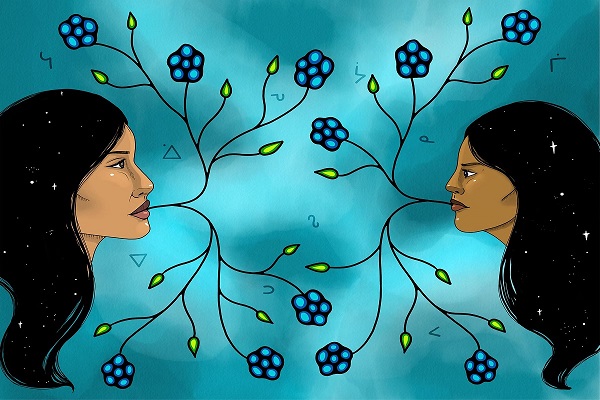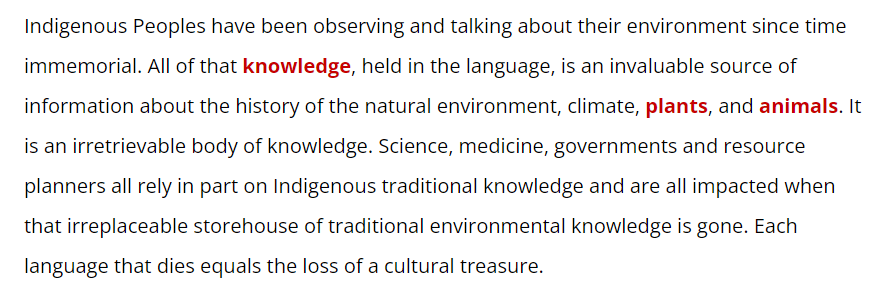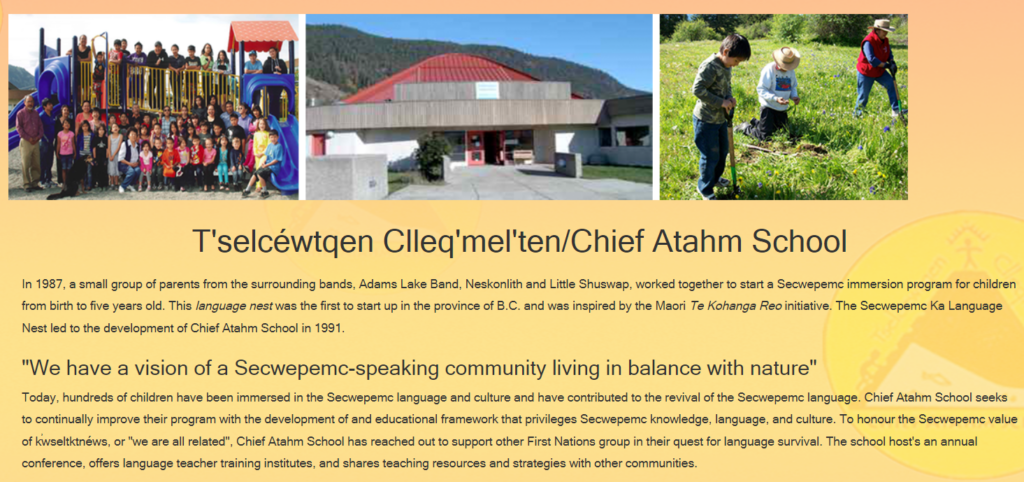“Our languages are living; they come from the land and they’re integral to our sense of self and a key aspect of self-determination”
Assembly of First Nations
Research on language revitalization exists under the umbrella of Decolonization and Re-Indigenization, but has a much more narrow focus specifically on increasing Indigenous language use, vitality and integration into communities.
Languages hold within them entire knowledge systems, unique ways of existing and interacting with the world, cultural teachings and historical events. Indigenous languages can not be separated from the land, culture, history and ethical teachings, and that is why when a language is taken away from a group of people the intersecting effects are detrimental.
The Root of Language Revitalization

Prior to colonization, it is estimated that there were roughly 300 distinct Indigenous languages in North America.
The true number of languages is actually unknown due to the fact that many of them disappeared before they could be documented as they were primarily oral languages. Today, more than two-thirds of Indigenous languages spoken in what is known as Canada are endangered. These languages have been classified as endangered using a multifaceted method to assess language vitality created by the United Nations Educational, Scientific and Cultural Organization. Some Indigenous languages in Canada are only spoken by a few hundred people and this is also the case across Turtle Island and what is known as South America. The number of some Indigenous language speakers range from 6.5 million speakers to a mere 2 speakers.
During the era of Residential Institutions, it is estimated that 150,000 children were removed from their communities and families and forbidden to speak their languages. When these children grew up and had children of their own, they frequently did not teach or encourage their own children to speak their language largely due to shame, trauma and English being the dominant language.
When we multiply this scenario by a few generations we arrive at the 2016 statistic that shows only 16% of Indigenous people are able to speak an Indigenous language.
Action Item
What is known as British Columbia is home to 204 First Nations communities and an amazing diversity of Indigenous languages; approximately 50% of the First Peoples’ languages of Canada are spoken in B.C.
Let’s take a look at the languages that come from this land within this interactive map provided by the First People’s Cultural Council that outlines the area in which the language is traditionally spoken, as well as how many speakers there currently are.
In 2019, Indigenous Corporate Training Inc. wrote this statement regarding the necessity of Indigenous Languages:

Language is the foundation of culture, and for Indigenous peoples in what is now known as Canada it is absolutely critical that these knowledge systems disseminated through language are kept intact, and intergenerational knowledge transfer resumes. When a language dies so does the link to the cultural and historical past. Without that crucial connection to their linguistic and cultural history, people lose their sense of identity and belonging.
Action Item
Immersion Grassroots Movements that have Forged the Way
Long before Indigenous research was accepted into academic spaces as openly as it is today, grassroots organizers have been working diligently to combat the language loss that is happening within their Nations.
One example of this is Chief Atahm Elementary. The below image has been taken directly from the Chief Atahm Website found here.

Secwépemc history, language and culture guide the curriculum. Elders, parents and teachers have been working together for over 30 years within this immersion learning environment. This immersion school has been so successful that it now goes up until grade 10, and has had multiple graduates move forward to becoming Secwepemctsín teachers themselves. If you’d like to read more about the process of starting Chief Atahm, this article is a great place to start.
In the province known as Quebec, another immersion school set up in 1988. Karihwanoron is a grass-roots initiative; over seen by parents and a board known as the Entity/Rontenon’ha Tsi Tehatikah’neratie. This learning environment was established by mothers from the Mohawk Territory of Kahnawà:ke, when they decided that it was necessary to establish a Mohawk immersion program to serve the greater community in an effort to revitalize the language.

Their vision was to create a home-like environment for children so that they could live the language immersed in the philosophy of the Kanien’kehá:ka. Karihwanoron is an alternative learning environment where the children are immersed in a home-environment, operated around the traditional festivals and ceremonies. To learn more about Karihwanoron please visit their website here.
These are just two examples of on the ground advocacy for languages that exist, but their existence has made ripples far beyond what their founders could have dreamed. Organizations like this are responsible for much of the research being done today in efforts to further language revitalization, and have provided models for what methods work best.
Examples of Language Revitalization Research
Within the field there are many different focus topics that researchers may speak about, ranging from social impacts of language learning to the specific linguistic elements within certain dialects.
Below are some excellent research papers to use and build your understanding as to what research into language revitalization can look like, as well as the varieties of ways the findings can be applied. This is by no means an exhaustive list of work that exists, but topics have been chosen to show a wide variety.
Please take a few minutes now to explore some examples of research being done in Language Revitalization.
Current Political Momentum & How to Engage
After years of advocacy by Indigenous peoples, the Government of Canada has a legislated commitment to respecting Indigenous languages in 2019 through the Indigenous Languages Act. This does not mean that magically now all Indigenous languages will automatically recover, but it does give the legal grounds for further advocation of legislation to establish long-term, sustainable, consistent, appropriate approaches to support First Nations in their efforts to recover, reclaim, maintain and normalize Indigenous languages.
Please take a moment to go through the following slides.
The above mean nothing though, if Individuals are not willing to get involved to assure that these organizations and governmental agencies are held accountable for their promises.
Some practical steps individuals can take to engage with language revitalization regardless of whether they work in research include:
- Being aware of the entire Language and Culture section of the Truth and Reconciliation Commissions 94 Calls to Action
- Learn the traditional name of where you live, the name of the people of that land and a simple greeting in that language.
- Challenge family members and colleagues to learn some phrasing in the traditional language of where you live or work
- Stay up to date on progress made on the Indigenous Languages Act, and challenge your local government to continue working on it.
- Try and bring the local language into your workplace through signage or curriculum
Action Item
Concluding Thoughts
Now that you have a preliminary understanding into the variety and complexity of Indigenous languages, as well as the efforts at play to help them thrive again, let’s move to module 4 and focus on learning about the people of the land of which this University inhabits.
